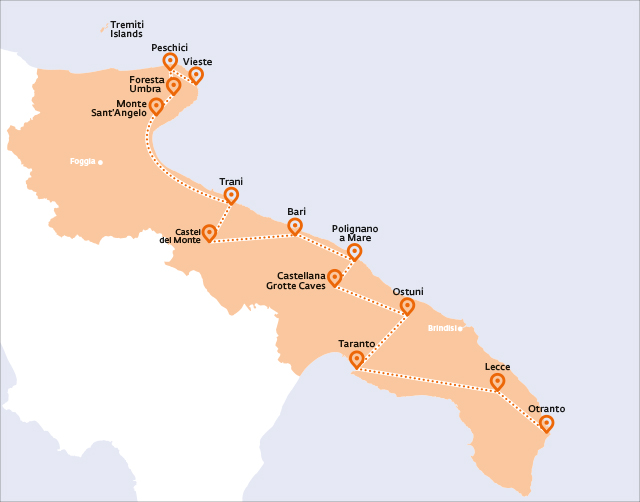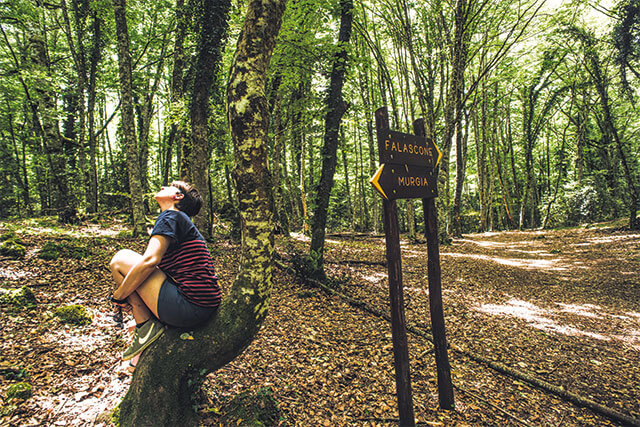
On the spur of the Italian boot, the Gargano boasts some of Puglia’s most spectacular scenery. Base yourself in the attractive whitewashed town of Vieste (or in Peschici) for a couple of days exploring the Gargano National Park. The coast, with its plunging white cliffs and idyllic beaches, is the obvious attraction, but venture inland and you’ll discover fine walking and cycling in the Foresta Umbra, listed among UNESCO Primeval Beech Forests. To the south, you can visit the site where the Archangel Michael supposedly appeared to a local bishop in remote Monte Sant’Angelo (also inscribed in the UNESCO World Heritage List). Off-shore, the Tremiti Islands offer stunning seascapes and swimming.


Known as the ‘Pearl of Puglia’, the coastal town of Trani boasts a picturesque marina and a handsome historic centre. Here, among its winding streets and medieval churches, you’ll find two synagogues, testament to the town’s important Jewish history. Trani’s headline act, however, is its celebrated seafront cathedral. Dedicated to St Nicholas the Pilgrim, it’s a masterpiece of austere Romanesque architecture with a sober facade and elegant bell tower. Some 34 km southwest of Trani, the UNESCO-listed Castel del Monte is one of Puglia’s most iconic sights. Enigmatic and magnetically beautiful, its distinct octagonal form is visible from miles around as it towers over the lush green countryside. Mystery surrounds its original function and still today scholars debate why Frederick II built it in the 13th century.
Puglia’s fiery capital has energy to burn. For visitors, the main focus is Bari Vecchia, the atmospheric old town where old ladies roll orecchiette pasta on skinny lanes and students crowd into lively bars. Lording over the area is the beautiful Cathedral of San Sabino and the Basilica of San Nicola, a Puglian-Romanesque cathedral built in the 12th century to house the relics of St Nicholas (aka Santa Claus) which had been brought from Turkey in 1087. Nearby, you can stroll the elegant seafront promenade and browse shop fronts in the 19th-century Murattiano quarter, the bustling heart of the modern city.

Polignano a Mare makes for some magical photos with its compact historic centre rising out of a craggy ravine pockmarked with marine caves. All around, the blue sky and sea frame the scene perfectly – the same blue that inspired local boy Domenico Modugno to pen his worldwide hit Nel blu dipinto di blu, also know as Volare. In the crowded summer months, action centres on the popular local beach known as the Lama Monachile. Finished in Polignano, head 17 km southwest to the Castellana Grotte Caves. This spectacular complex of limestone caverns is reckoned to be Italy’s longest natural subterranean network.
First discovered in 1938, the caves are accessed through a vast 60m-deep cavern known as the Grave. Beyond this, you enter a world of fantastical karst formations, stalactites and stalagmites, many given nicknames by early explorers – look out for the Roman wolf, the owl, the Leaning Tower of Pisa. The highlight is the otherworldly Grotta Bianca (White Grotto), named after its extraordinary alabaster stalactites.

The ‘white city’ of Ostuni rises above oceans of silver-grey olive trees at the eastern end of the Itria Valley. En route from the Castellana Caves you’ll pass through a succession of beautiful towns including Alberobello, crammed with conical-roofed trulli (UNESCO site) and Locorotondo, famous for its crisp white wine. In Ostuni, the main activity is strolling the atmospheric streets, taking in the attractive arches, buttresses, baroque trimmings and stairways. Crowning the whole package is an impressive 15th-century cathedral with an unusual Gothic-Romanesque facade.
On the instep of the Italian boot, Taranto hides its charms behind a rather rough-and-ready appearance. But look beneath the surface and you’ll discover a city rich in history and culture. Its prize attraction is the MArTA – Museo Archeologico Nazionale, one of Italy’s premier archaeological museums, whose collection recalls the city’s golden age as an important power during the time of Magna Graecia.
Other highlights include the city’s 15th-century Aragonese castle and its cathedral, one of Puglia’s oldest Romanesque buildings.
Lecce, dubbed the Florence of the South, is a sunny university city renowned for its extravagant baroque architecture. Known as barocco leccese (Lecce baroque), this exuberant style finds form in a wealth of 17th- and 18th-century palazzos and churches. Chief among these is the Basilica of Santa Croce, whose facade is a mesmerizing ensemble of cherubs, angels and assorted beasts. Further glories await on Piazza del Duomo, the city’s focal square, which is flanked by the 12th-century cathedral and Palazzo Vescovile (Bishop’s Palace).


A classic white town on the Adriatic, Otranto is a popular summer hangout. But for all its festive atmosphere, it has a bloody history – in 1480 Turkish invaders massacred 813 citizens when they refused to convert to Islam. The victims’ bones are today interred in Otranto’s Norman cathedral, a graceful 11th-century building boasting an astonishing mosaic depicting the tree of life. The town’s other principal sight is its Aragonese castle which inspired Horace Walpole’s 1764 novel The Castle of Otranto.

BuyPuglia is the digital system tailored to suit your tourism business in Puglia. Our matching platform is an easy tool to explore meeting opportunities with Puglian suppliers and learn about their tourism &.. cultural products. BuyPuglia ranks buyers and sellers based on entered information. Shared interests are paired, helping plan effective meetings and delivering optimized supply &.. demand solutions.